Page Summary
-
This guide explains how to integrate DT Exchange (formerly Fyber Marketplace) ads into an Android app using Google Mobile Ads SDK mediation, focusing on waterfall integrations.
-
The DT Exchange mediation adapter supports waterfall integrations for Banner, Interstitial, Rewarded, and Native ad formats, with Bidding in closed beta.
-
Requirements for integration include Android API level 23 or higher, the latest Google Mobile Ads SDK, and completing the mediation Get Started guide.
-
Setting up involves configuring your app and ad placements in the DT Exchange UI to obtain necessary IDs and keys, and updating your app-ads.txt file.
-
You need to set up DT Exchange demand in the Ad Manager UI by adding DT Exchange as an ad network company and configuring ad unit mapping for waterfall integrations.
This guide shows you how to use Google Mobile Ads SDK to load and display ads from DT Exchange using mediation, covering waterfall integrations. It covers how to add DT Exchange to an ad unit's mediation configuration and how to integrate the DT SDK and adapter into an Android app.
Supported integrations and ad formats
The mediation adapter for DT Exchange has the following capabilities:
| Integration | |
|---|---|
| Bidding | 1 |
| Waterfall | |
| Formats | |
| Banner | |
| Interstitial | |
| Rewarded | 2 |
| Native | |
1 Bidding integration is in closed beta, reach out to your account manager to request access.
2 Rewarded ad format for iOS bidding is in alpha.
Requirements
Android API level 23 or higher
[For bidding]: To integrate all supported ad formats in bidding, use the DT Exchange adapter 8.4.0.1 or higher (latest version recommended).
Latest Google Mobile Ads SDK.
Complete the mediation Get started guide.
Step 1: Set up configurations in DT Exchange UI
Add new app and ad placement
Sign up or log in to DT Exchange Console.
Click Add App.
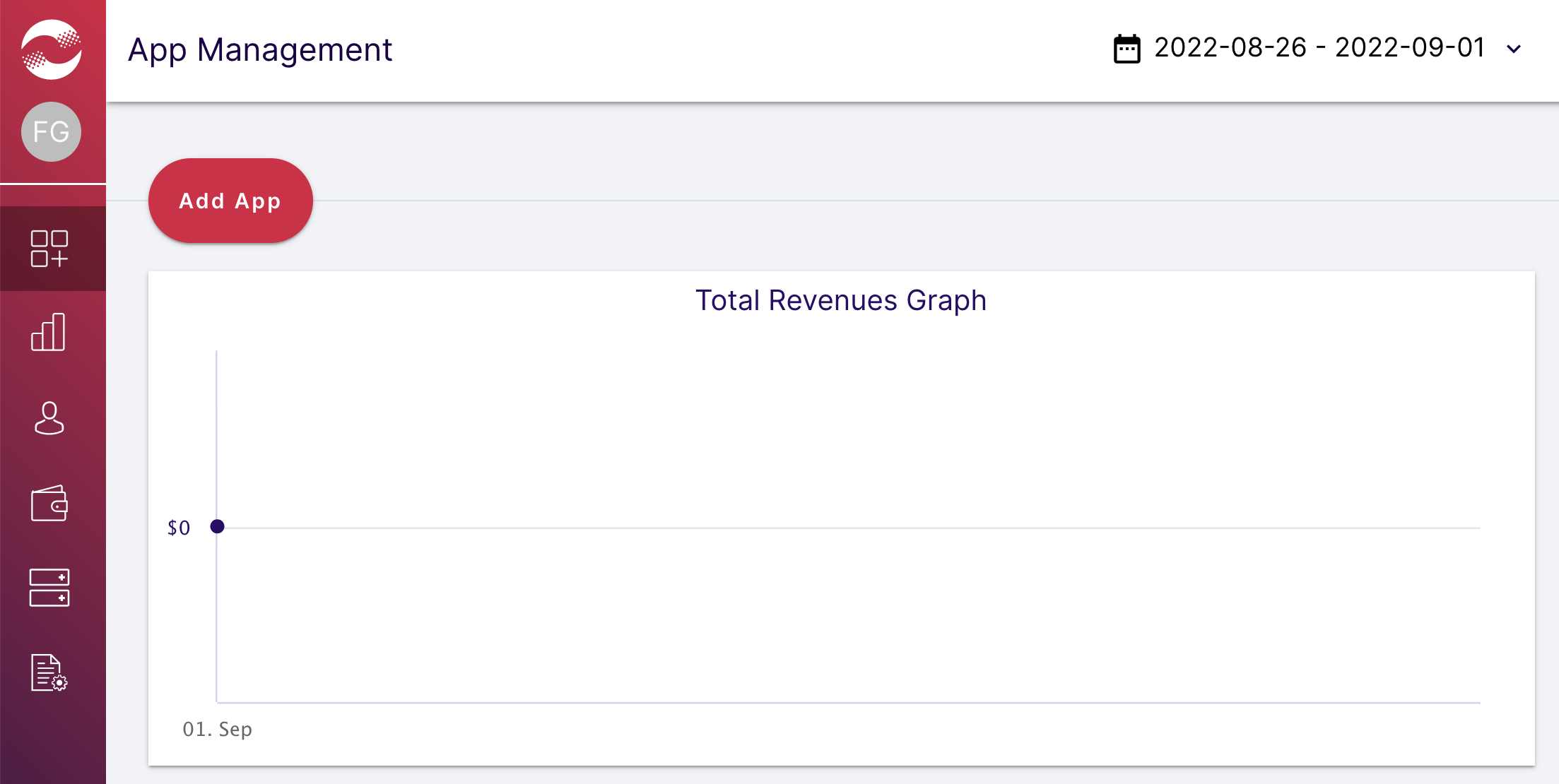
Choose your platform and placements, fill out the rest of the form, and then click Create App.
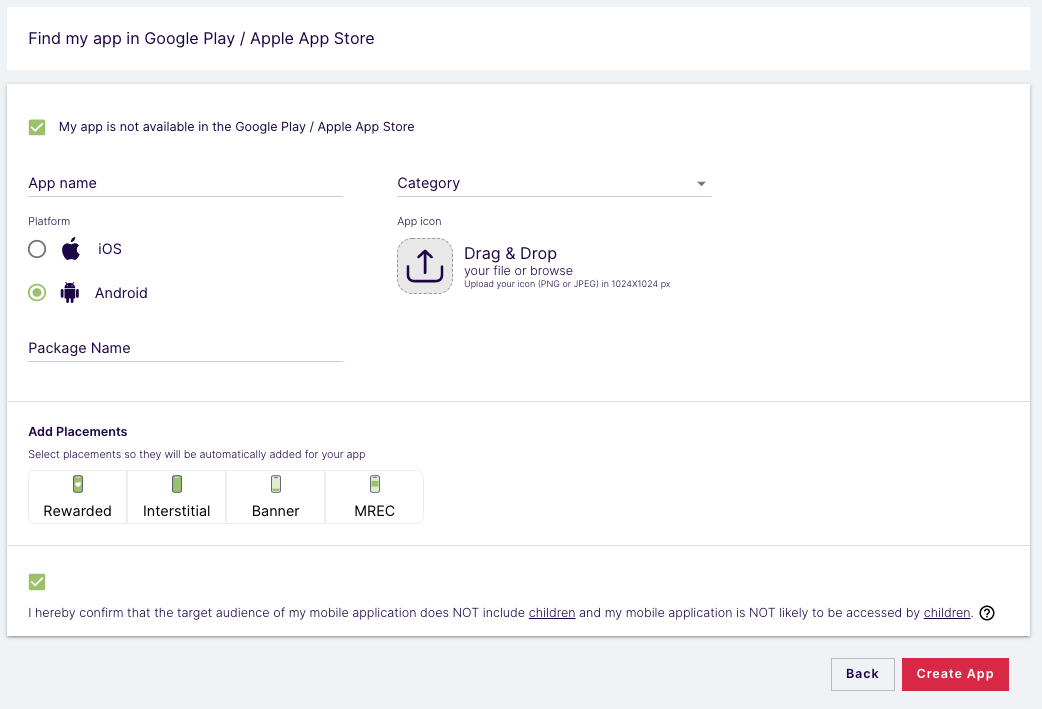
Enter the names and select the types for your placements. Then, click Save Placement.
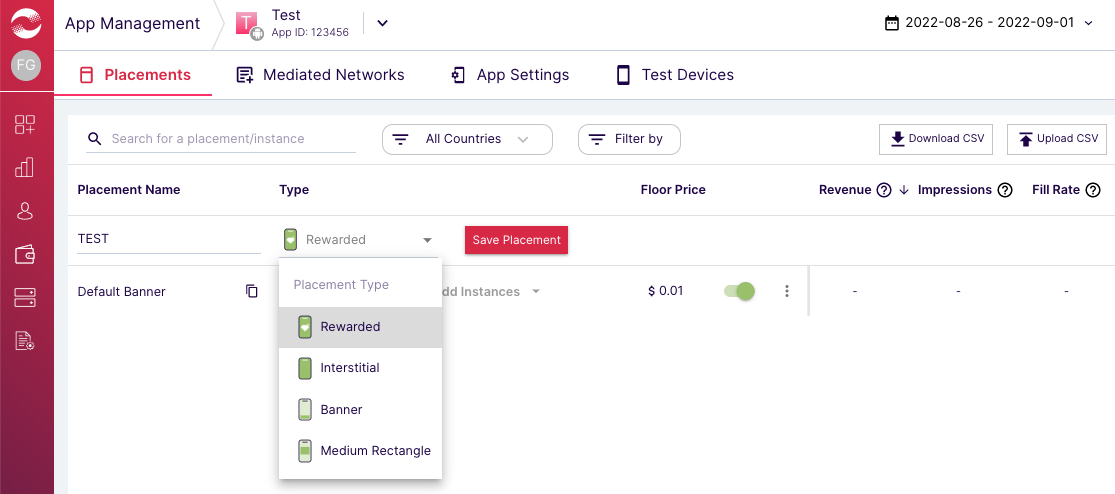
App ID and Placement ID
Hover over the left navigation bar to open it, then click App Management.
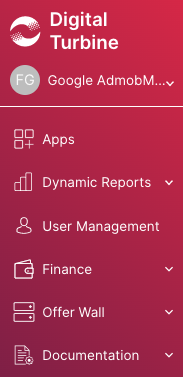
On the App Management page, take note of the App ID next to your app.
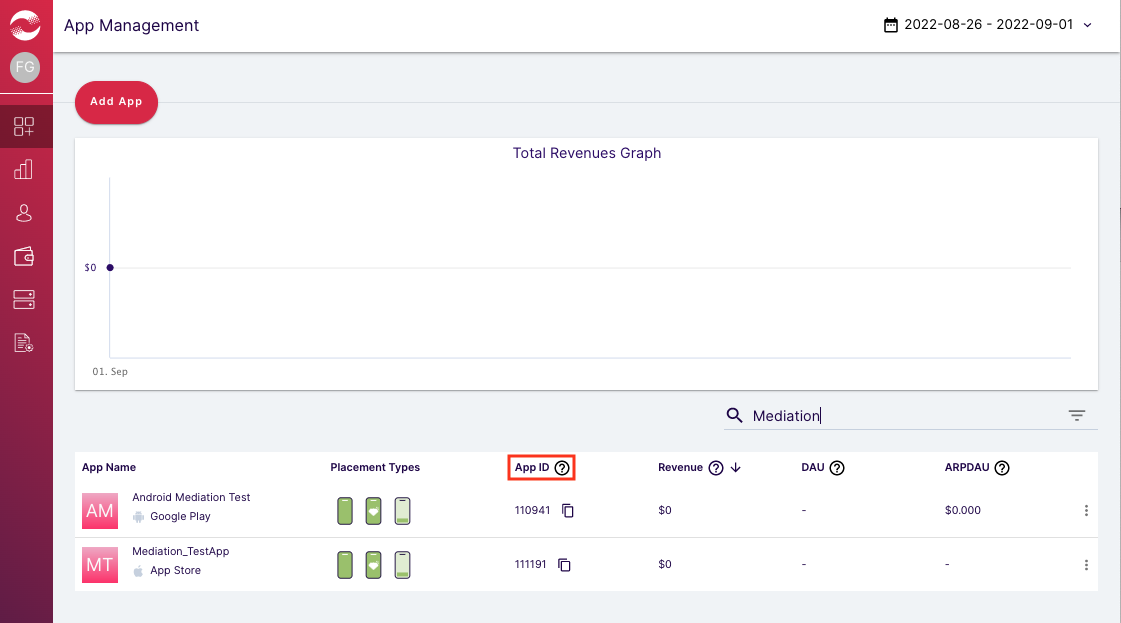
Select your app and navigate to the Placements tab. Take note of the Placement ID..
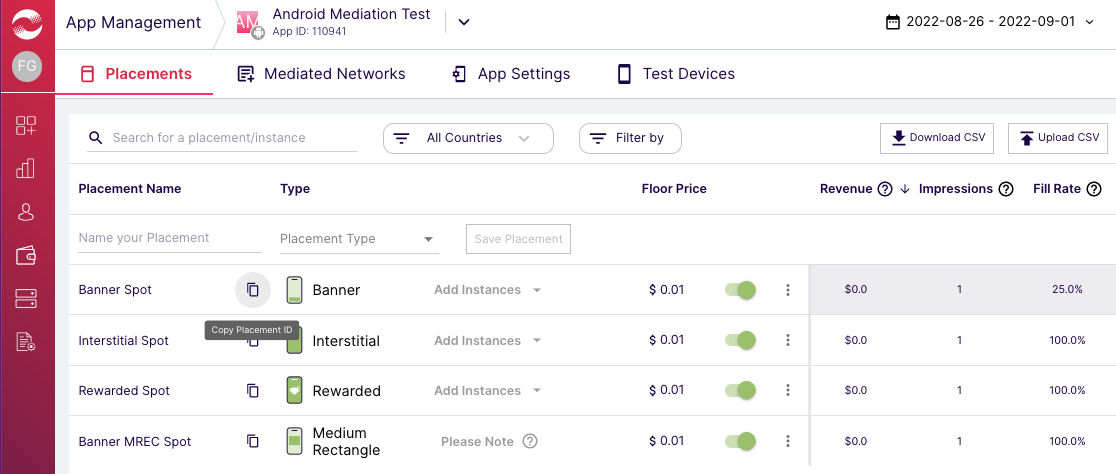
Publisher ID, Consumer Key and Consumer Secret
Click your username from the left menu and select User Profile.
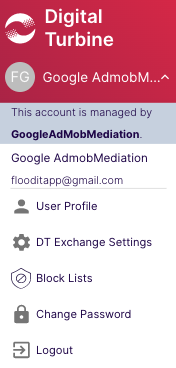
Take note of the Publisher ID, Consumer Key, and Consumer Secret as these are needed in the next step.

Update your app-ads.txt
Authorized Sellers for Apps app-ads.txt is an IAB Tech Lab initiative that helps ensure your
app ad inventory is only sold through channels you've identified as authorized. To prevent a
significant loss in ad revenue, you'll need to implement an app-ads.txt file.
If you haven't done so already,
create an app-ads.txt file for Ad Manager.
To implement app-ads.txt for DT Exchange,
Add DT to your app-ads.txt file.
Step 2: Set up DT Exchange demand in Ad Manager UI
Sign in to your Ad Manager account.
Add DT Exchange in Companies
Bidding
This step isn't required for bidding integrations.
Waterfall
Navigate to Admin > Companies, then click the New company button in the All companies tab. Select Ad network.
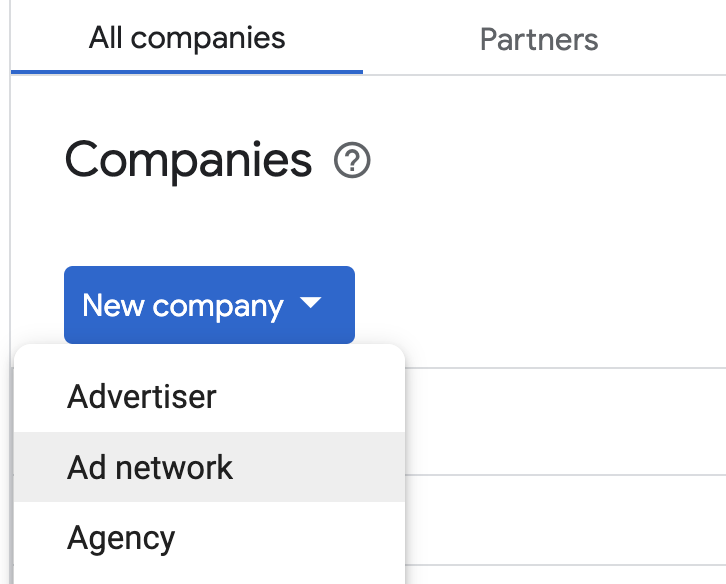
Select DT Exchange as the Ad network, enter a unique Name and enable Mediation. Turn on Automatic data collection, and enter the Publisher ID, Consumer Secret and Consumer Key obtained in the previous section.
You don't need to enter a Username or Password. Click Save when done.

Enable secure signal sharing
Bidding
Navigate to Admin > Global settings. Go to the Ad Exchange account settings tab and review and toggle on Secure signal sharing. Click Save.
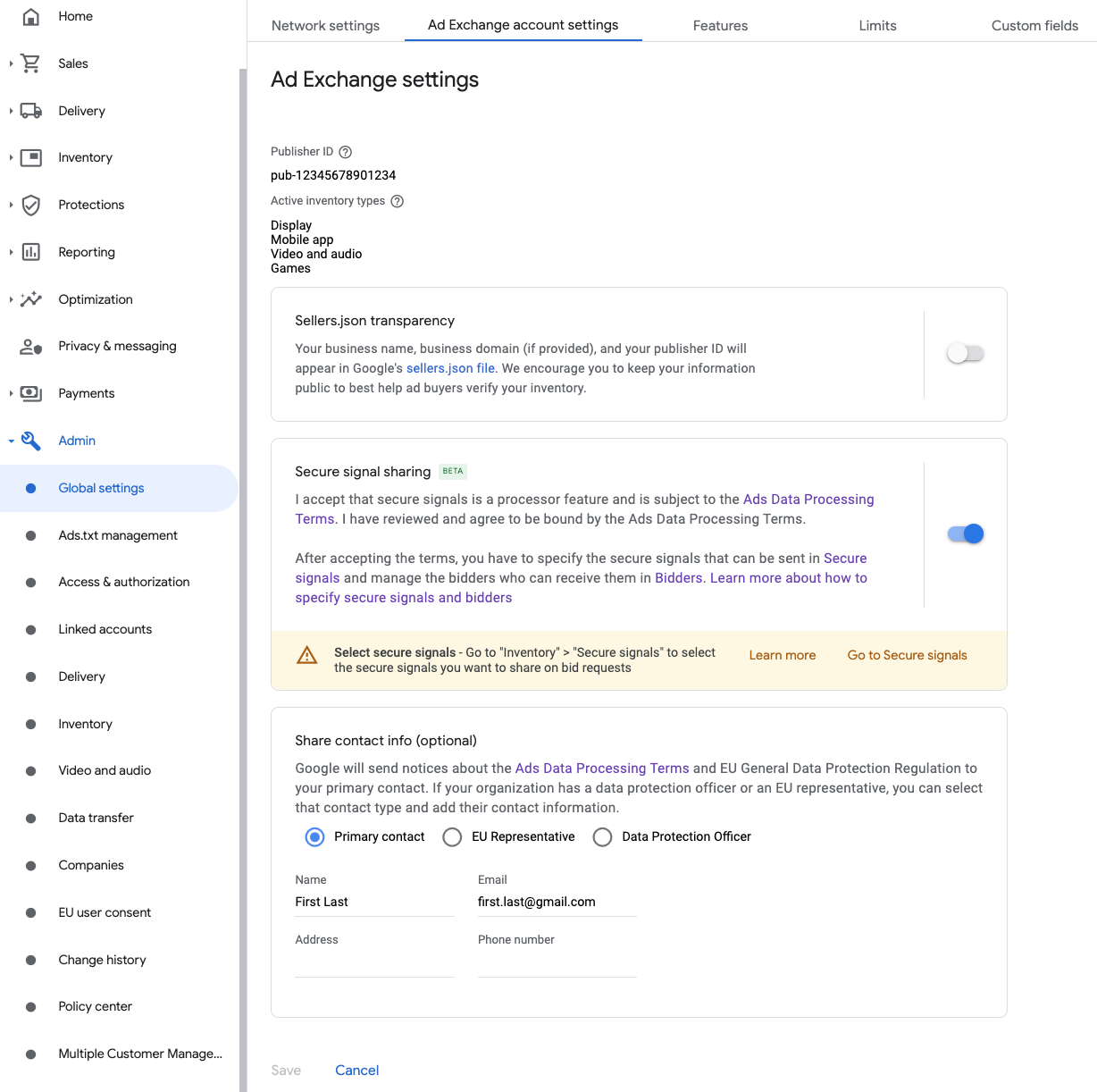
Waterfall
This step isn't required for waterfall integrations.
Share secure signal on bid requests
Bidding
Navigate to Inventory > Secure Signals. Under Secure signals, search for DT Exchange (Fyber Monetization) and toggle on Enable app integration.
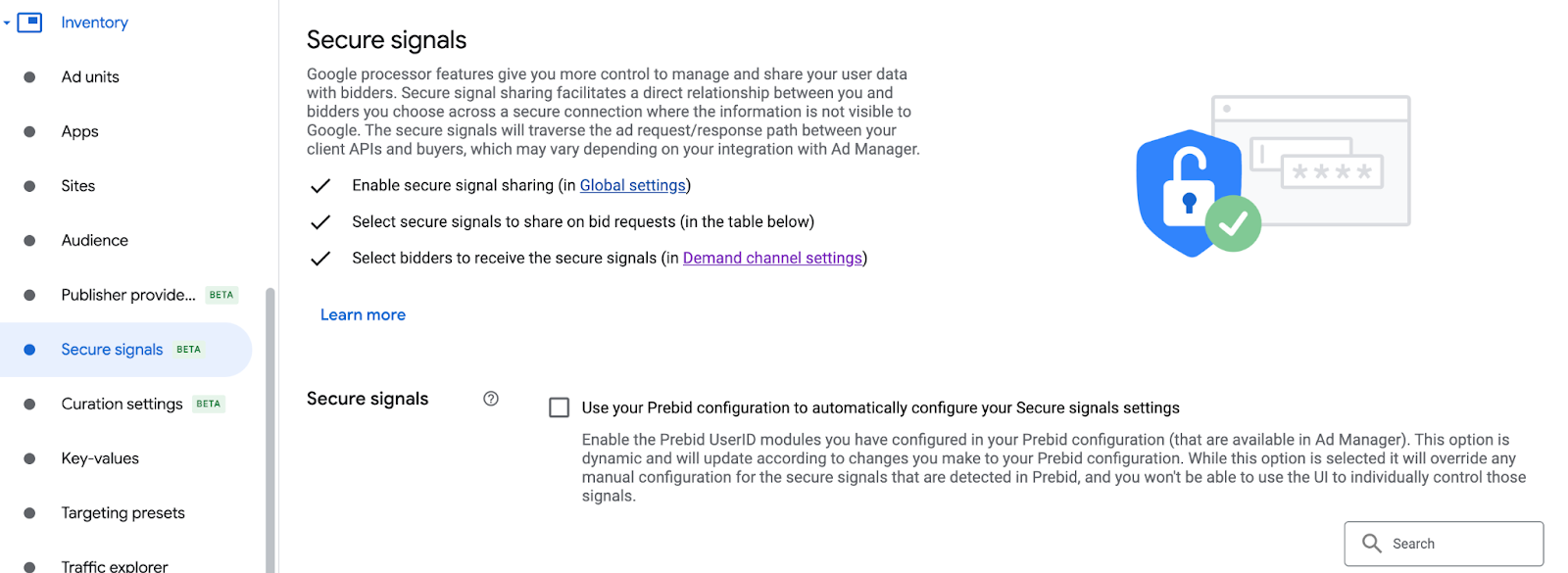
Click Save.
Waterfall
This step isn't required for waterfall integrations.
Allow secure signal sharing for SDK Bidding
Bidding
Navigate to Delivery > Demand channel settings. In the Default settings tab, toggle on Allow secure signal sharing for SDK Bidding.
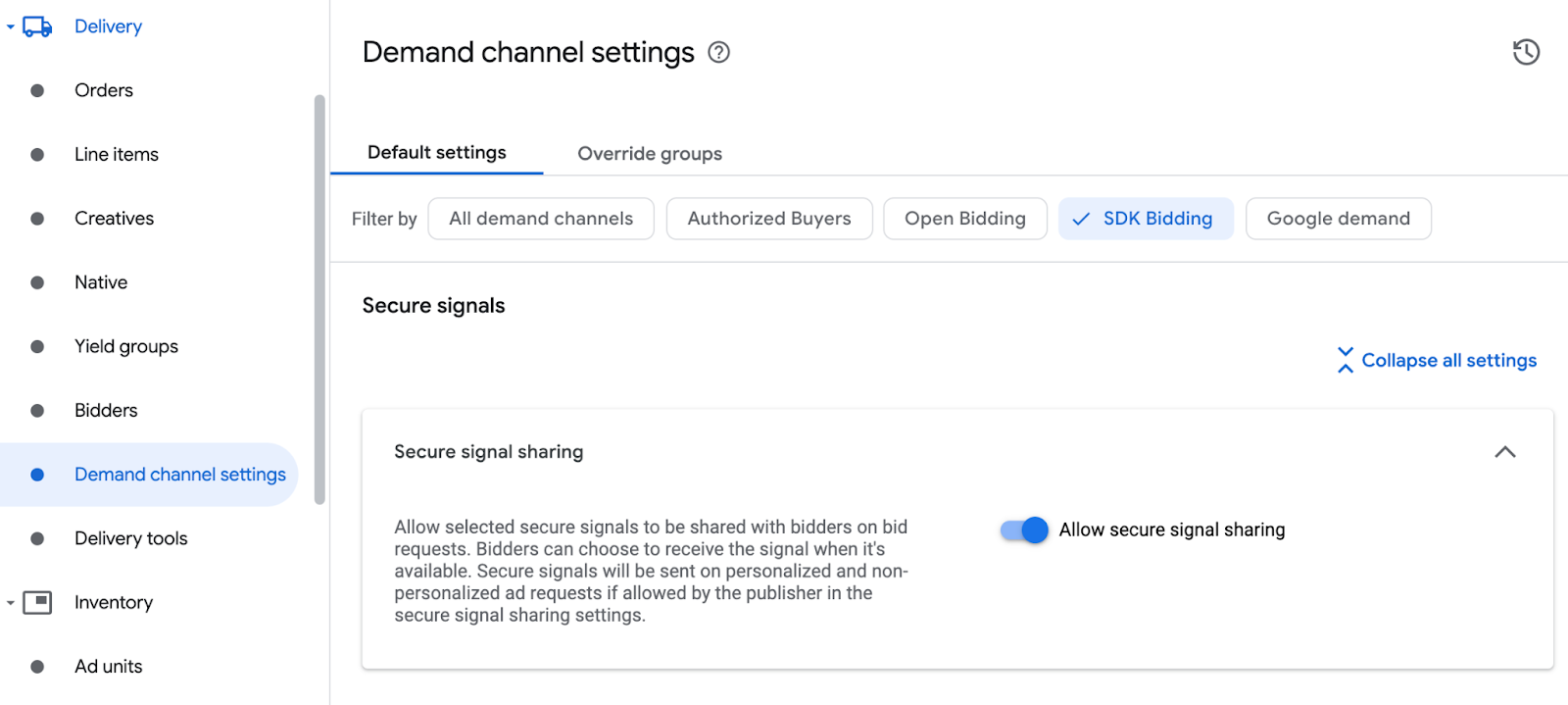
Click Save.
Waterfall
This step isn't required for waterfall integrations.
Configure DT Exchange bidding
Bidding
Navigate to Delivery > Bidders, and click Go to SDK Bidding.
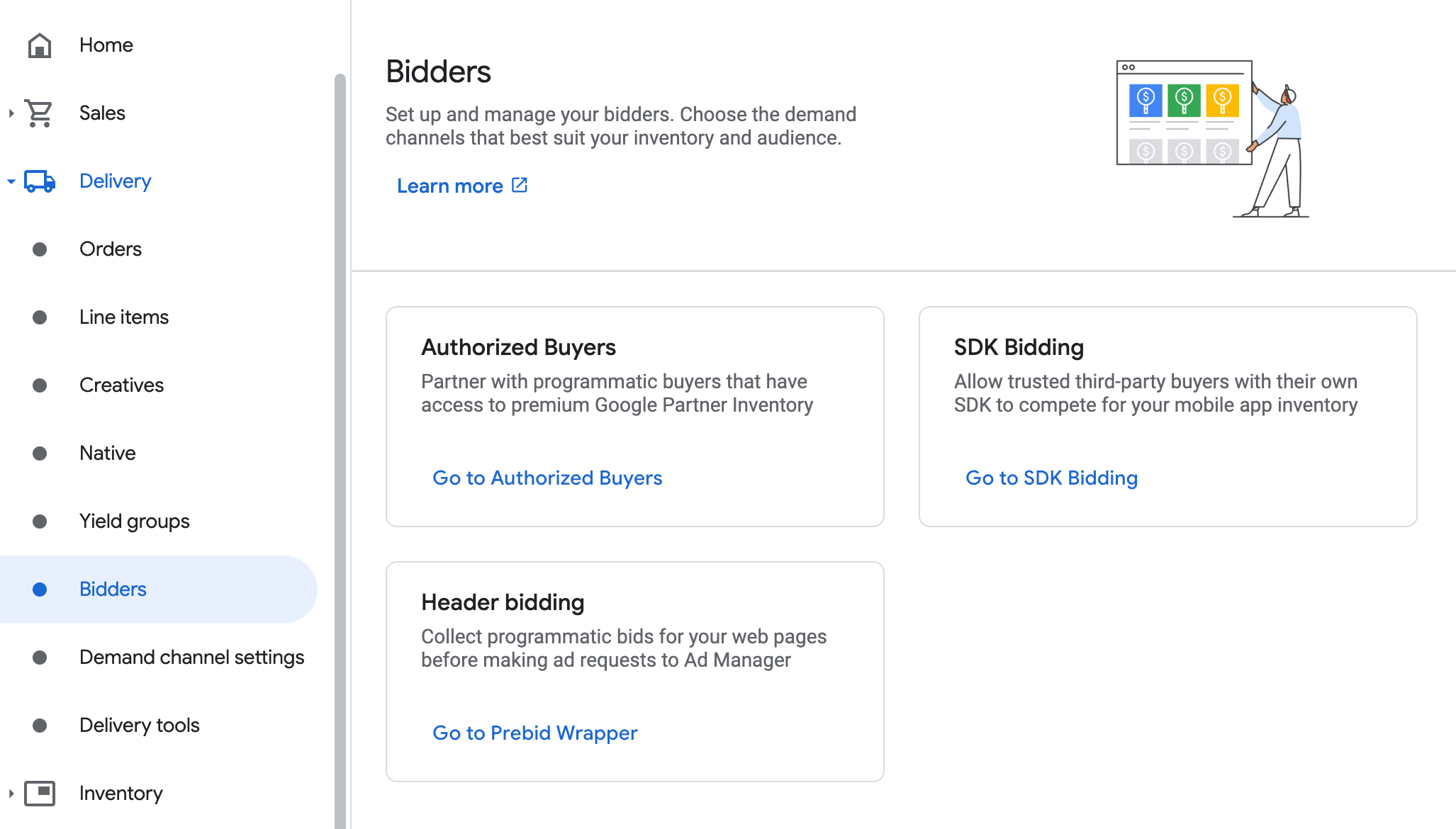
Click New bidder.
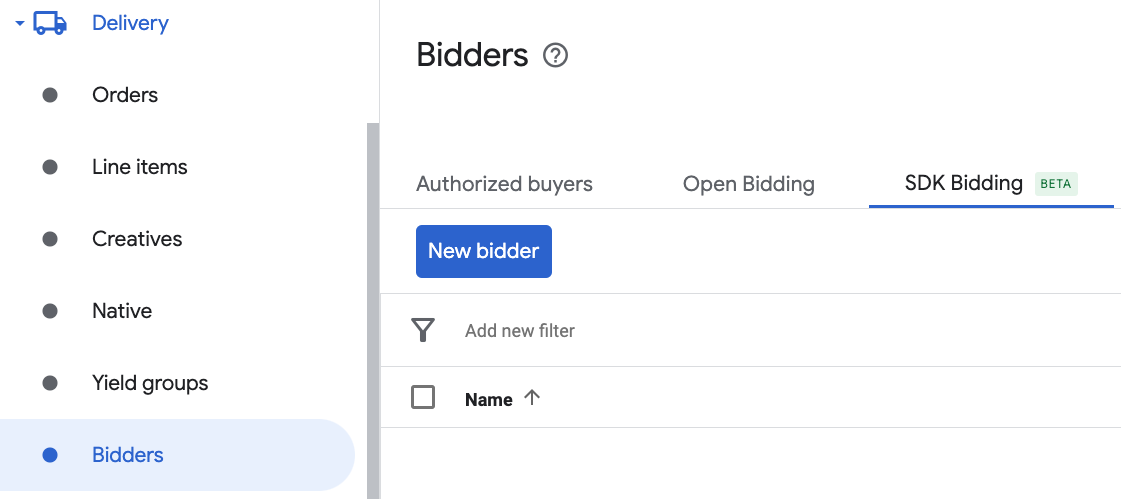
Select DT Exchange as the bidder.

Click Continue to enable SDK Bidding for this bidder.
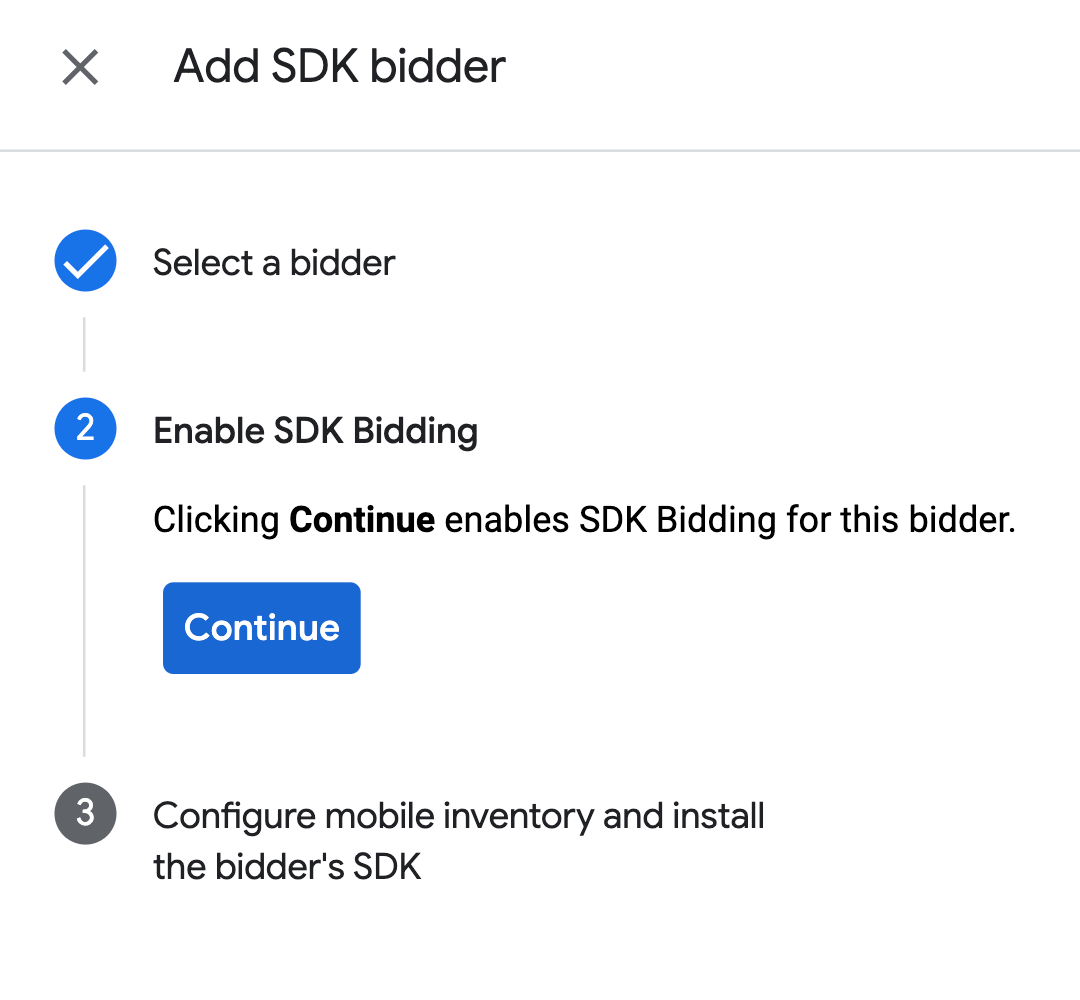
Click Done.
Waterfall
This step isn't required for waterfall integrations.
Configure ad unit mapping
Bidding
Navigate to Delivery > Bidders, and click Go to SDK Bidding.

Select the company for DT Exchange.

Go to the Ad unit mapping tab and click New ad unit mapping.

Choose Specific ad unit. Select an ad unit and format, Mobile app as the Inventory type, and your Mobile application. Then, enter Application ID and Placement ID obtained in the previous section. Finally, click Save.

Waterfall
Navigate to Delivery > Yield groups and click the New yield group button. Select your Mobile application.
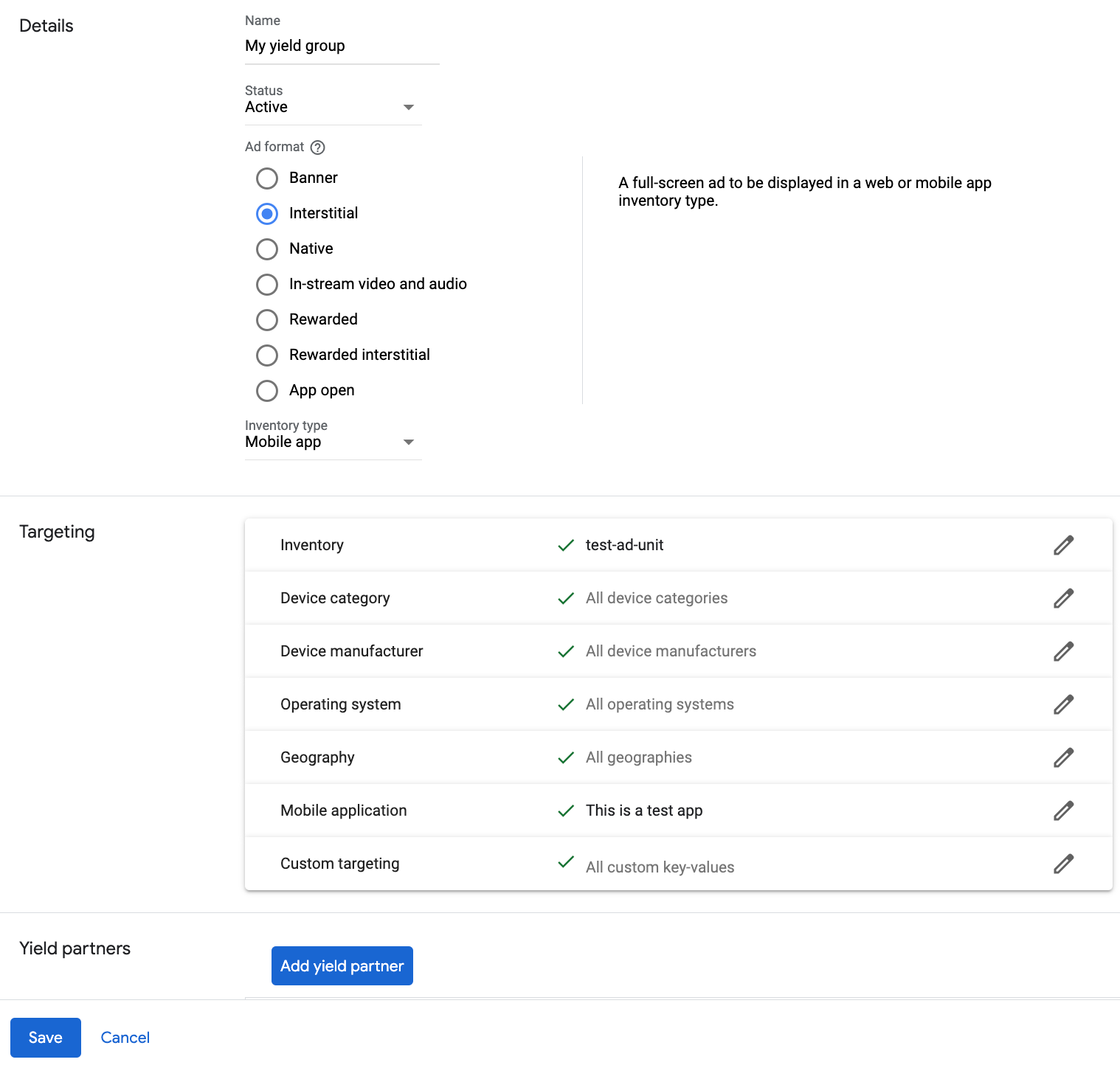
Scroll down and click Add yield partner.

Select the company you created for DT Exchange in the previous section. Choose Mobile SDK mediation as the Integration type, Android as the Platform, and Active as the Status.
Enter the Application ID and Placement ID obtained in the previous section, and the Default CPM value. Click Save.
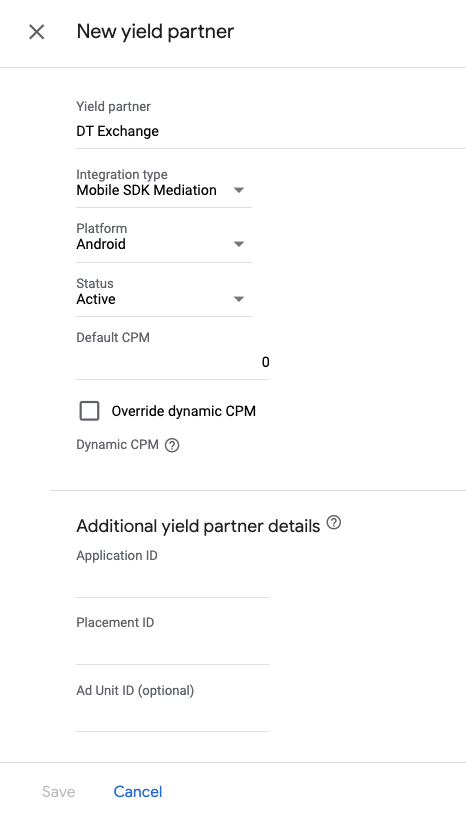
Note: Automatic data collection takes a few days to gather data before it can accurately calculate a Dynamic CPM value for a mediation network. Once the eCPM can be calculated, it is automatically updated on your behalf.
Add DT Exchange (Fyber Monetization) to GDPR and US state regulations ad partners list
Follow the steps in European regulations settings and US state regulations settings to add DT Exchange (Fyber Monetization) to the European and US state regulations ad partners list in the Ad Manager UI.
Step 3: Import the DT SDK and adapter
Android Studio integration (recommended)
In your app-level build.gradle.kts file, add the following implementation
dependencies and configurations. Use the latest versions of the DT SDK
and adapter:
dependencies {
implementation("com.google.android.gms:play-services-ads:24.9.0")
implementation("com.google.ads.mediation:fyber:8.4.1.0")
}
Manual integration
- Download the latest version of the
DT SDK for Android and
add
fyber-marketplace-x.y.z.aarto your project. - Navigate to the
DT Exchange adapter artifacts
on Google's Maven Repository. Select the latest version, download the DT
Exchange adapter's
.aarfile, and add it to your project.
Step 4: Implement privacy settings on DT SDK
EU consent and GDPR
To comply with Google EU User Consent Policy, you must make certain disclosures to your users in the European Economic Area (EEA), the UK, and Switzerland, and obtain their consent for the use of cookies or other local storage where legally required, and for the collection, sharing, and use of personal data for ads personalization. This policy reflects the requirements of the EU ePrivacy Directive and the General Data Protection Regulation (GDPR). You are responsible for verifying consent is propagated to each ad source in your mediation chain. Google is unable to pass the user's consent choice to such networks automatically.
Starting in DT Exchange SDK version 8.3.0, DT Exchange automatically reads GDPR consent set by consent management platforms that support Google's Additional Consent specification. For more information, see the DT Exchange GDPR implementation guide.
US states privacy laws
US states privacy laws require giving users the right to opt out of the "sale" of their "personal information" (as the law defines those terms), with the opt-out offered through a prominent "Do Not Sell My Personal Information" link on the "selling" party's homepage. The US states privacy laws compliance guide offers the ability to enable restricted data processing for Google ad serving, but Google is unable to apply this setting to each ad network in your mediation chain. Therefore, you must identify each ad network in your mediation chain that may participate in the sale of personal information and follow guidance from each of those networks to ensure compliance.
DT Exchange contains an API that lets you forward user consent to their SDK. The following sample code shows how to pass consent information to the DT SDK manually. Should you choose to pass consent information to the DT SDK manually, it is recommended that this code is called prior to requesting ads through Google Mobile Ads SDK.
Java
Kotlin
Replace US_PRIVACY_STRING with your US privacy string.
Visit DT Exchange's CCPA implementation guide for more details and the values that may be provided in the method.
Step 5: Add required code
Load ad with activity context
Pass Activity context when loading Interstitial ad formats. Without activity
context, ad load will fail.
Step 6: Test your implementation
Enable test ads
Make sure you register your test device for Ad Manager.
Verify test ads
To verify that you are receiving test ads from DT Exchange, enable single ad source testing in ad inspector using the DT Exchange (Bidding) and DT Exchange (Waterfall) ad source(s).
Optional steps
Network-specific parameters
The DT Exchange adapter supports additional request parameters that can be passed to the adapter as an Android Bundle. The adapter looks for the following keys in the bundle:
| Request parameters and values | |
|---|---|
InneractiveMediationDefs.KEY_AGE
|
Integer. The age of the user |
FyberMediationAdapter.KEY_MUTE_VIDEO
|
Boolean. Mute or unmute video |
Here's a code example of how to set these ad request parameters:
Java
Bundle extras = new Bundle();
extras.putInt(InneractiveMediationDefs.KEY_AGE, 10);
extras.putBoolean(FyberMediationAdapter.KEY_MUTE_VIDEO, false);
AdRequest request =
new AdRequest.Builder().addNetworkExtrasBundle(FyberMediationAdapter.class, extras).build();
Kotlin
val extras = Bundle()
extras.putInt(InneractiveMediationDefs.KEY_AGE, 10)
extras.putBoolean(FyberMediationAdapter.KEY_MUTE_VIDEO, false)
val request =
AdRequest.Builder().addNetworkExtrasBundle(FyberMediationAdapter::class.java, extras).build()
Error codes
If the adapter fails to receive an ad from DT Exchange, you can check the
underlying error from the ad response using
ResponseInfo.getAdapterResponses()
under the following class:
com.google.ads.mediation.fyber.FyberMediationAdapter
Here are the codes and accompanying messages thrown by the DT Exchange adapter when an ad fails to load:
| Error code | Reason |
|---|---|
| 101 | DT Exchange server parameters configured in the Ad Manager UI are missing/invalid. |
| 103 | The requested ad size does not match a DT Exchange supported banner size. |
| 105 | DT SDK loaded an ad but returned an unexpected controller. |
| 106 | Ad is not ready to display. |
| 107 | Context is not an activity instance. |
| 200-399 | DT SDK returned an error. See code for more details. |
DT Exchange Android Mediation Adapter Changelog
Version 8.4.1.0
- Verified compatibility with DT Exchange SDK 8.4.1.
Built and tested with:
- Google Mobile Ads SDK version 24.8.0.
- DT Exchange SDK version 8.4.1.
Version 8.4.0.1
- Added support for Native Ads
- Verified compatibility with DT Exchange SDK 8.4.0.
Built and tested with:
- Google Mobile Ads SDK version 24.7.0.
- DT Exchange SDK version 8.4.0.
Version 8.4.0.0
- Removed class-level references to Context. Can help reduce memory leak issues.
- Verified compatibility with DT Exchange SDK 8.4.0.
Built and tested with:
- Google Mobile Ads SDK version 24.6.0.
- DT Exchange SDK version 8.4.0.
Version 8.3.8.0
- Refactored the error codes into a new DTExchangeErrorCodes.kt file.
- Verified compatibility with DT Exchange SDK 8.3.8.
Built and tested with:
- Google Mobile Ads SDK version 24.5.0.
- DT Exchange SDK version 8.3.8.
Version 8.3.7.0
- Updated adapter to support bidding for banner, interstitial and rewarded ad formats.
- Verified compatibility with DT Exchange SDK 8.3.7.
Built and tested with:
- Google Mobile Ads SDK version 24.1.0.
- DT Exchange SDK version 8.3.7.
Version 8.3.6.1
- Updated the minimum required Android API level to 23.
- Updated the minimum required Google Mobile Ads SDK version to 24.0.0.
Built and tested with:
- Google Mobile Ads SDK version 24.0.0.
- DT Exchange SDK version 8.3.6.
Version 8.3.6.0
- Verified compatibility with DT Exchange SDK 8.3.6.
Built and tested with:
- Google Mobile Ads SDK version 23.6.0.
- DT Exchange SDK version 8.3.6.
Version 8.3.5.0
- Verified compatibility with DT Exchange SDK 8.3.5.
Built and tested with:
- Google Mobile Ads SDK version 23.6.0.
- DT Exchange SDK version 8.3.5.
Version 8.3.4.0
- Verified compatibility with DT Exchange SDK 8.3.4.
Built and tested with:
- Google Mobile Ads SDK version 23.6.0.
- DT Exchange SDK version 8.3.4.
Version 8.3.3.0
- Verified compatibility with DT Exchange SDK 8.3.3.
Built and tested with:
- Google Mobile Ads SDK version 23.5.0.
- DT Exchange SDK version 8.3.3.
Version 8.3.2.0
- Verified compatibility with DT Exchange SDK 8.3.2.
Built and tested with:
- Google Mobile Ads SDK version 23.4.0.
- DT Exchange SDK version 8.3.2.
Version 8.3.1.0
- Verified compatibility with DT Exchange SDK 8.3.1.
Built and tested with:
- Google Mobile Ads SDK version 23.3.0.
- DT Exchange SDK version 8.3.1.
Version 8.3.0.0
- Added support for passing the Google Mobile Ads SDK version to DT Exchange SDK.
- Verified compatibility with DT Exchange SDK 8.3.0.
Built and tested with:
- Google Mobile Ads SDK version 23.2.0.
- DT Exchange SDK version 8.3.0.
Version 8.2.7.0
- Verified compatibility with DT Exchange SDK 8.2.7.
Built and tested with:
- Google Mobile Ads SDK version 23.0.0.
- DT Exchange SDK version 8.2.7.
Version 8.2.6.1
- Updated the minimum required Google Mobile Ads SDK version to 23.0.0.
- Verified compatibility with DT Exchange SDK 8.2.6.
Built and tested with:
- Google Mobile Ads SDK version 23.0.0.
- DT Exchange SDK version 8.2.6.
Version 8.2.6.0
- Verified compatibility with DT Exchange SDK 8.2.6.
Built and tested with:
- Google Mobile Ads SDK version 22.6.0.
- DT Exchange SDK version 8.2.6.
Version 8.2.5.0
- Verified compatibility with DT Exchange SDK 8.2.5.
Built and tested with:
- Google Mobile Ads SDK version 22.5.0.
- DT Exchange SDK version 8.2.5.
Version 8.2.4.0
- Verified compatibility with DT Exchange SDK 8.2.4.
Built and tested with:
- Google Mobile Ads SDK version 22.3.0.
- DT Exchange SDK version 8.2.4.
Version 8.2.3.0
- Updated adapter to use new
VersionInfoclass. - Updated the minimum required Google Mobile Ads SDK version to 22.0.0.
Built and tested with:
- Google Mobile Ads SDK version 22.0.0.
- DT Exchange SDK version 8.2.3.
Version 8.2.2.1
- Added support for passing
muteVideokey in mediation extra to mute interstitial ads.
Built and tested with:
- Google Mobile Ads SDK version 21.5.0.
- DT Exchange SDK version 8.2.2.
Version 8.2.2.0
- Verified compatibility with DT Exchange SDK 8.2.2.
- Updated the minimum required Google Mobile Ads SDK version to 21.5.0.
Built and tested with:
- Google Mobile Ads SDK version 21.5.0.
- DT Exchange SDK version 8.2.2.
Version 8.2.1.0
- Rebranded adapter name to "DT Exchange".
- Verified compatibility with DT Exchange SDK 8.2.1.
- Updated the minimum required Google Mobile Ads SDK version to 21.3.0.
Built and tested with:
- Google Mobile Ads SDK version 21.3.0.
- DT Exchange SDK version 8.2.1.
Version 8.2.0.0
- Verified compatibility with Fyber SDK 8.2.0.
- Updated the minimum required Google Mobile Ads SDK version to 21.1.0.
Built and tested with:
- Google Mobile Ads SDK version 21.1.0.
- Fyber SDK version 8.2.0.
Version 8.1.5.0
- Verified compatibility with Fyber SDK 8.1.5.
Built and tested with:
- Google Mobile Ads SDK version 21.0.0.
- Fyber SDK version 8.1.5.
Version 8.1.4.0
- Verified compatibility with Fyber SDK 8.1.4.
Built and tested with:
- Google Mobile Ads SDK version 21.0.0.
- Fyber SDK version 8.1.4.
Version 8.1.3.1
- Updated
compileSdkVersionandtargetSdkVersionto API 31. - Updated the minimum required Google Mobile Ads SDK version to 21.0.0.
- Updated the minimum required Android API level to 19.
Built and tested with:
- Google Mobile Ads SDK version 21.0.0.
- Fyber SDK version 8.1.3.
Version 8.1.3.0
- Verified compatibility with Fyber SDK 8.1.3.
- Updated the minimum required Google Mobile Ads SDK version to 20.6.0.
Built and tested with:
- Google Mobile Ads SDK version 20.6.0.
- Fyber SDK version 8.1.3.
Version 8.1.2.0
- Verified compatibility with Fyber SDK 8.1.2.
- Updated the minimum required Google Mobile Ads SDK version to 20.5.0.
Built and tested with:
- Google Mobile Ads SDK version 20.5.0.
- Fyber SDK version 8.1.2.
Version 8.1.0.0
- Verified compatibility with Fyber SDK 8.1.0.
Built and tested with:
- Google Mobile Ads SDK version 20.4.0.
- Fyber SDK version 8.1.0.
Version 7.8.4.1
- Fixed an issue where the adapter would not initialize if there is a duplicate or more than one unique app ID from the mediation configurations.
- Updated the minimum required Google Mobile Ads SDK version to 20.4.0.
Built and tested with:
- Google Mobile Ads SDK version 20.4.0.
- Fyber SDK version 7.8.4.
Version 7.8.4.0
- Verified compatibility with Fyber SDK 7.8.4.
- Updated the minimum required Google Mobile Ads SDK version to 20.3.0.
- Fixed an issue with rewarded display ads, where
onVideoComplete()was not called. - Fyber now requires an Activity context to show ads.
Built and tested with:
- Google Mobile Ads SDK version 20.3.0.
- Fyber SDK version 7.8.4.
Version 7.8.3.0
- Verified compatibility with Fyber SDK 7.8.3.
- Added standardized adapter error codes and messages.
- Updated the minimum required Google Mobile Ads SDK version to 20.1.0.
Built and tested with:
- Google Mobile Ads SDK version 20.1.0.
- Fyber SDK version 7.8.3.
Version 7.8.2.0
- Verified compatibility with Fyber SDK 7.8.2.
- Updated the minimum required Google Mobile Ads SDK version to 20.0.0.
Built and tested with:
- Google Mobile Ads SDK version 20.0.0.
- Fyber SDK version 7.8.2.
Version 7.8.1.0
- Verified compatibility with Fyber SDK 7.8.1.
Built and tested with:
- Google Mobile Ads SDK version 19.7.0.
- Fyber SDK version 7.8.1.
Version 7.8.0.0
- Verified compatibility with Fyber SDK 7.8.0.
- Updated the minimum required Google Mobile Ads SDK version to 19.7.0.
Built and tested with:
- Google Mobile Ads SDK version 19.7.0.
- Fyber SDK version 7.8.0.
Version 7.7.4.0
- Verified compatibility with Fyber SDK 7.7.4.
- Fixed an issue where
onUserEarnedReward()is forwarded twice for rewarded ads.
Built and tested with:
- Google Mobile Ads SDK version 19.5.0.
- Fyber SDK version 7.7.4.
Version 7.7.3.0
- Verified compatibility with Fyber SDK 7.7.3.
Built and tested with:
- Google Mobile Ads SDK version 19.5.0.
- Fyber SDK version 7.7.3.
Version 7.7.2.0
- Verified compatibility with Fyber SDK 7.7.2.
- Updated the minimum required Google Mobile Ads SDK version to 19.5.0.
Built and tested with:
- Google Mobile Ads SDK version 19.5.0.
- Fyber SDK version 7.7.2.
Version 7.7.1.0
- Verified compatibility with Fyber SDK 7.7.1.
- Updated the minimum required Google Mobile Ads SDK version to 19.4.0.
Built and tested with:
- Google Mobile Ads SDK version 19.4.0.
- Fyber SDK version 7.7.1.
Version 7.7.0.0
- Verified compatibility with Fyber SDK 7.7.0.
Built and tested with:
- Google Mobile Ads SDK version 19.3.0.
- Fyber SDK version 7.7.0.
Version 7.6.1.0
- Verified compatibility with Fyber SDK 7.6.1.
Built and tested with:
- Google Mobile Ads SDK version 19.3.0.
- Fyber SDK version 7.6.1.
Version 7.6.0.0
- Verified compatibility with Fyber SDK 7.6.0.
- Updated the adapter to support inline adaptive banner requests.
- Updated the minimum required Google Mobile Ads SDK version to 19.3.0.
- Fixed a bug where onAdOpened()/onAdClosed() methods were not being called for banner ads.
Built and tested with:
- Google Mobile Ads SDK version 19.3.0.
- Fyber SDK version 7.6.0.
Version 7.5.4.0
- Verified compatibility with Fyber SDK 7.5.4.
- Updated the minimum required Google Mobile Ads SDK version to 19.1.0.
Built and tested with:
- Google Mobile Ads SDK version 19.1.0.
- Fyber SDK version 7.5.4.
Version 7.5.3.0
- Verified compatibility with Fyber SDK 7.5.3.
Built and tested with:
- Google Mobile Ads SDK version 19.0.1.
- Fyber SDK version 7.5.3.
Version 7.5.2.0
- Verified compatibility with Fyber SDK 7.5.2.
- Updated the minimum required Google Mobile Ads SDK version to 19.0.1.
Built and tested with:
- Google Mobile Ads SDK version 19.0.1.
- Fyber SDK version 7.5.2.
Version 7.5.0.0
- Verified compatibility with Fyber SDK 7.5.0.
- Fixed NullPointerException crash during Fyber ad loading.
Built and tested with:
- Google Mobile Ads SDK version 18.3.0.
- Fyber SDK version 7.5.0.
Version 7.4.1.0
- Verified compatibility with Fyber SDK 7.4.1.
- Updated the minimum required Google Mobile Ads SDK version to 18.3.0.
Built and tested with:
- Google Mobile Ads SDK version 18.3.0.
- Fyber SDK version 7.4.1.
Version 7.3.4.0
- Initial release!
- Supports Banner, Interstitial and Rewarded ads.
Built and tested with:
- Google Mobile Ads SDK version 18.2.0.
- Fyber SDK version 7.3.4.

